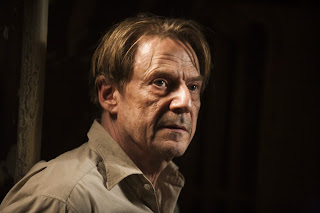“The Debt” is an unglamorous thriller that’s not about car chases or gunfights, or unlikely leaps from one building to another. There are guns, there’s a van, and there’s an attempt to escape from East Berlin, but “The Debt” goes deeper into its characters, imprisoning the four main characters inside an East Berlin apartment and inside their own tortured lives.
The prey: In the winter of 1965-66, three Mossad agents are under cover in East Berlin to extract a Nazi war criminal, the “Surgeon of Birkenau,” and return him to Israel for trial. The Nazi doctor is now “Dr. Bernhardt,” a kindly old obstetrician with a practice in East Berlin. Jesper Christensen gives a chilling performance as the Nazi monster who can appear benevolent, charming, and lethal inside seconds.
 |
| Jesper Christensen as the Surgeon of Birkenau |
The searchers:
- Stephan Gold (played by Marton Csokas in 1966, then Tom Wilkinson in 1997), to put it very simply, wants revenge and glory. He is a political animal, and an angry one. His rage is barely contained in his younger days, and well-directed by experience as he ages. Stephan’s furious piano playing in the East Berlin apartment was particularly frightening. Csokas is the only one of the primary actors with whom I’m unfamiliar, and while I cannot yet pronounce his name, I won’t forget it.
- David Peretz (Sam Worthington in 1966, Ciaran Hinds in 1997) wants justice, and he wants it publicly: The world must know. His sole purpose is the mission. He seems to live on despair as if he was doomed from birth just for surviving. Worthington’s face is bland, childlike, often immobile. David keeps a mask in place as long as he can. Only two things break through his discipline — the Surgeon of Birkenau and Rachel Singer.
- Rachel Singer (Jessica Chastain in 1966, Helen Mirren in 1997) may just want to be worthy of having survived. She had been a translator, and the East Berlin mission is her first time in the field. She is determined, but not yet as hardened as Stephan and not as fiercely stoic as David. Soon after the mission, her life revolves around keeping the truth of the mission a secret, perhaps to protect herself, Stephan, and David as much as daughter Sara.
 |
| Chastain, Csokas, Worthington as Rachel, Stephan, and David in 1966. |
The film goes back and forth between the mission in 1965-66 and its aftermath thirty years later. The symmetries between Tom Wilkinson and Martin Csokas as Stephan as well as Helen Mirren and Jessica Chastain as Rachel are remarkable.
The older Stephan is as well written and acted as the younger — an angry young man grown up, ambitious, arrogant, manipulative, not one to deny himself the objects of his lust or to restrain his fury. Mirren’s Rachel is Chastain grown much stronger after thirty years of building a persona for the world to see. Accustomed to being in the public eye, only David can force Rachel to reflect. Worthington’s David is less clear, and Ciaran Hinds as David thirty years later seems to be out of sync with the other actors. He has enormous sad eyes, but his character’s actions speak much louder than his words. The character David travels far in his quest for redemption, leaving Rachel to follow his path to its end. I know this, yet it seems to me David was more effective offscreen than either Worthington or Hinds were onscreen. In the 1997 story, David reappears like a revenant, unfulfilled in his mission for the world to know the truth, both about the Surgeon of Birkenau, and about 1966.
Excellent lighting helps to differentiate the locations and times of the film: 1966 East Berlin was dingy, wet and cold. More rain entered the apartment than light. Once back in Israel, Tel Aviv was bright, wide open, hot with a fresh wind. The film makes powerful use of repetition in small details of scenes; in its lighting design ranging from grays to blacks to bright whites; in sudden changes from what we’d seen before and therefore anticipated.
 |
| Helen Mirren as Rachel in 1997. |
“The Debt” is based on an Israeli film, “Ha-Hov” written by Assaf Bernstein and Ido Rosenblum, directed by the former.
Matthew Vaughn & Jane Goldman and Peter Straughan have crafted a screenplay for “The Debt” that is taut and disturbing. Director John Madden does a fabulous job, filling the film with strained nerves, gasps, sharp turns, yet still providing food for thought. Thomas Newman’s score adds to the suspense, as does Alexander Berner’s editing and Ben Davis’ cinematography. Excellent fight choreography by Peter Pedrero presents very real people sweating, grunting, panting with the extraordinary effort to kill, capture, or just survive.
“The Debt” has many white-knuckle scenes which do not dissipate like mist after the movie ends. This is an intelligent thriller, its violence intimate and terrifying, its humanity sadly fragile.
~ Molly Matera, signing off, but not shutting off the light. The world is far too scary for that.





